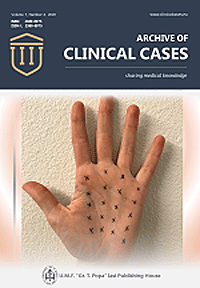Pulmonary tuberculosis
Tuberculosis is a chronic inflammation caused by Mycobacterium tuberculosis (tubercle bacillus, Koch bacillus) - human type or bovine type. The most affected organ by tuberculosis is the lung.
Pulmonary tuberculosis is classified in primary and secondary.
Primary tuberculosis
The Ghon complex is the pathognomonic macroscopical lesion of primary pulmonary tuberculosis and it results from Koch bacillus (Mycobacterium tuberculosis) initial infection, in children. It contains three elements (Figure 1) :
- The Ghon focus is a small nodular lesion (aprox. 1 cm), white-yellowish, with central caseous necrosis, encapsulated, located in the middle third of the lung (the lower part of the upper lobe or upper part of the lower lobe), subpleural.
- Lymphadenitis is caused by the lymphatic dissemination of Koch bacillus into the hilar lymph nodes which appear enlarged, firm, yellowish-white, with or without central caseous necrosis.
- Lymphangitis, only radiologically visible, presents as a discrete linear opacity with erased contour and miliary nodules in "string of pearls" aligned along the lymphatic vessel. It represents the tuberculous inflammation of the lymphatics linking the Ghon focus and the hilar lymph nodes.

Figure 1 : Child lung with Ghon complex (primary tuberculosis)
Primary pulmonary tuberculosis has a favorable evolution, with healing by fibrosis and/or calcification, in 95 % of cases, resulting in Ranke complex. Otherwise, it evolves into progressive primary tuberculosis, which includes the following entities :
- Primary caseous pneumonia occurs by the local extension of the Ghon focus to an entire lobe or segment, the affected area gaining a consolidated appearance, yellow-gray, with low consistency (caseuos necrosis). It can have a severe evolution with liquefaction and drainage of the central necrosis through the airways, resulting primary tuberculous cavern.
- Tuberculous bronchopneumonia appears secondary to the bronchogenic local spread of the disease, from the primary tuberculous complex to the entire lung parenchyma, especially at the base of the lung. Therefore, it results patchy circumscribed foci with a diameter of 0.5-1 cm, white to yellowish, centered by a bronchi, separated by normal lung parenchyma (polycyclic tubercles).
- Miliary tuberculosis appears due to hematogenous dissemination of Koch bacilli, local (lung) (Figure 2) or distant (most common kidneys, liver, spleen, meninges). It presents as multiple small nodular lesions (2-3 mm), well-defined, yellowish, millet seeds like, spread over the entire surface of the affected organ (miliary tubercles).

Figure 2 : Child lung with miliary tuberculosis
Microscopically, the characteristic lesion in tuberculosis is the tuberculous granuloma (Figure 3, 4 and 5).

Figure 3 : Tuberculous granuloma is localized in the pulmonary interstitium, compressing the surrounding alveoli and destroing the parenchyma. (Hematoxylin-eosin, ob. x4) (For detailed histological description of granuloma, see tuberculous granuloma.)

Figure 4 : Tuberculous granuloma in the pulmonary interstitium. (Hematoxylin-eosin, ob. X20)

Figure 5 : Tuberculous granuloma in the pulmonary interstitium. (Hematoxylin-eosin, ob. x20)
Additional information :

